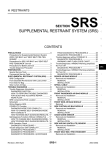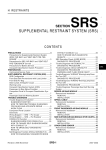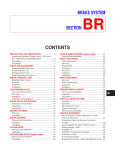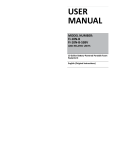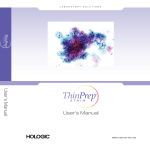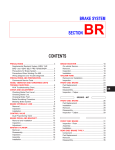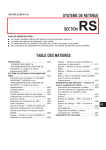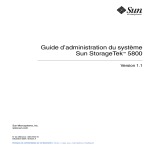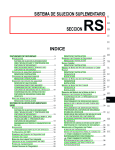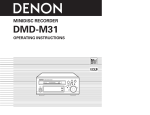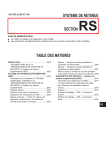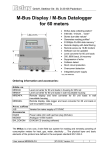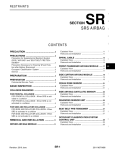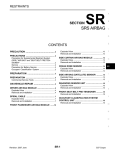Download RESTRAINT SYSTEM SECTION RS
Transcript
RESTRAINT SYSTEM SECTION RS CONTENTS SEAT BELTS ...................................................................2 Precautions ..................................................................2 Front Seat Belt.............................................................4 SUPPLEMENTAL RESTRAINT SYSTEM (SRS)............6 Precautions ..................................................................6 Preparation ..................................................................7 SRS Configuration .......................................................8 Seat Belt Pre-tensioner with Load Limiter...................9 Built-in Type Side Air Bag............................................9 SRS Component Parts Location ...............................10 Maintenance Items ....................................................10 Diagnosis Sensor Unit ...............................................11 Front Seat Belt Pre-tensioner....................................12 Side Air Bag (Satellite) Sensor..................................13 Driver Air Bag Module and Spiral Cable ...................14 Front Passenger Air Bag Module ..............................17 Front Side Air Bag Module ........................................18 Disposal of Air Bag Module and Seat Belt Pretensioner ....................................................................20 Trouble Diagnoses Introduction.................................26 How to Perform Trouble Diagnoses for Quick and Accurate Repair ..................................................29 Schematic ..................................................................31 Wiring Diagram - SRS -.............................................32 SRS Operation Check ...............................................36 Trouble Diagnoses with CONSULT-II..................37 Trouble Diagnoses without CONSULT-II.............46 Trouble Diagnoses: ″AIR BAG″ Warning Lamp Does Not Turn Off .....................................................54 Trouble Diagnoses: ″AIR BAG″ Warning Lamp Does Not Turn On .....................................................56 Collision Diagnosis ....................................................57 SEAT BELTS Precautions SUPPLEMENTAL RESTRAINT SYSTEM (SRS) “AIR BAG” AND “SEAT BELT PRE-TENSIONER” The Supplemental Restraint System such as “AIR BAG” and “SEAT BELT PRE-TENSIONER” used along with a seat belt, helps to reduce the risk or severity of injury to the driver and front passenger for certain types of collision. The SRS composition which is available to NISSAN MODEL R20 is as follows (The composition varies according to the destination and optional equipment.): I For a frontal collision The Supplemental Restraint System consists of driver air bag module (located in the center of the steering wheel), front passenger air bag module (located on the instrument panel on passenger side), front seat belt pre-tensioners, a diagnosis sensor unit, warning lamp, wiring harness and spiral cable. I For a side collision The Supplemental Restraint System consists of front side air bag module (located in the outer side of front seat), side air bag (satellite) sensor, diagnosis sensor unit (one of components of air bags for a frontal collision), wiring harness, warning lamp (one of components of air bags for a frontal collision). WARNING: I To avoid rendering the SRS inoperative, which could increase the risk of personal injury or death in the event of a collision which would result in air bag inflation, all maintenance should be performed by an authorized NISSAN dealer. I Improper maintenance, including incorrect removal and installation of the SRS, can lead to personal injury caused by unintentional activation of the system. I Do not use electrical test equipment on any circuit related to the SRS unless instructed to in this Service Manual. Spiral cable and wiring harnesses covered with yellow insulation tape either just before the harness connectors or for the complete harness are related to the SRS. Precaution for Seat Belt Service CAUTION: I Before removing the seat belt pre-tensioner assembly, turn the ignition switch off, disconnect both battery cables and wait at least 3 minutes. I Do not use electrical test equipment for seat belt pre-tensioner connector. I After replacing or reinstalling seat belt pre-tensioner assembly, or reconnecting seat belt pre-tensioner connector, check the system function. Refer to “SRS Operation Check” for details. (RS-36) I Do not disassemble buckle or seat belt assembly. I Replace anchor bolts if they are deformed or worn out. I Never oil tongue and buckle. I If any component of seat belt assembly is questionable, do not repair. Replace the whole seat belt assembly. I If webbing is cut, frayed, or damaged, replace seat belt assembly. I When replacing seat belt assembly, use a genuine seat belt assembly. After A Collision WARNING: Inspect all seat belt assemblies including retractors and attaching hardware after any collision. NISSAN recommends that all seat belt assemblies in use during a collision be replaced unless the collision was minor and the belts show no damage and continue to operate properly. Failure to do so could result in serious personal injury in an accident. Seat belt assemblies not in use during a collision should also be replaced if either damage or improper operation is noted. Seat belt pre-tensioner should be replaced even if the seat belts are not in use during a frontal collision in which the air bags are deployed. Replace any seat belt assembly if: I The seat belt was in use at the time of a collision (except for minor collisions and the belts, retractors and buckles show no damage and continue to operate properly). I The seat belt was damaged in an accident. (i.e. torn webbing, bent retractor or guide, etc.) I The seat belt attaching point was damaged in an accident. Inspect the seat belt attaching area for damage or distortion and repair as necessary before installing a new seat belt assembly. I Anchor bolts are deformed or worn out. RS-2 SEAT BELTS Precautions (Cont’d) NRS127 RS-3 SEAT BELTS Front Seat Belt REMOVAL AND INSTALLATION 1. 2. 3. 4. 5. Slide the seat all the way forward. Tilt the seatback toward the front and remove the rear floor boxes. Remove adjuster cover. Remove floor anchor bolt. Remove shoulder anchor bolt. Remove front and rear kicking plate, then remove center pillar upper and lower garnish. Refer to BT-18, “SIDE AND FLOOR TRIM” for details. 6. Disconnect seat belt pre-tensioner connector. 7. Remove the screw securing seat belt pre-tensioner retractor, then remove seat belt and seat belt pre-tensioner retractor. 8. Remove bolts securing seat belt adjuster, then remove seat belt adjuster. YRS093 RS-4 SEAT BELTS Front Seat Belt (Cont’d) YRS074 RS-5 SUPPLEMENTAL RESTRAINT SYSTEM (SRS) Precautions SUPPLEMENTAL RESTRAINT SYSTEM (SRS) “AIR BAG” AND “SEAT BELT PRE-TENSIONER” The Supplemental Restraint System such as “AIR BAG” and “SEAT BELT PRE-TENSIONER” used along with a seat belt, helps to reduce the risk or severity of injury to the driver and front passenger for certain types of collision. The SRS composition which is available to NISSAN MODEL R20 is as follows (The composition varies according to the destination and optional equipment.): I For a frontal collision The Supplemental Restraint System consists of driver air bag module (located in the center of the steering wheel), front passenger air bag module (located on the instrument panel on passenger side), front seat belt pre-tensioners, a diagnosis sensor unit, warning lamp, wiring harness and spiral cable. I For a side collision The Supplemental Restraint System consists of front side air bag module (located in the outer side of front seat), side air bag (satellite) sensor, diagnosis sensor unit (one of components of air bags for a frontal collision), wiring harness, warning lamp (one of components of air bags for a frontal collision). WARNING: I To avoid rendering the SRS inoperative, which could increase the risk of personal injury or death in the event of a collision which would result in air bag inflation, all maintenance should be performed by an authorized NISSAN dealer. I Improper maintenance, including incorrect removal and installation of the SRS, can lead to personal injury caused by unintentional activation of the system. I Do not use electrical test equipment on any circuit related to the SRS unless instructed to in this Service Manual. Spiral cable and wiring harnesses covered with yellow insulation tape either just before the harness connectors or for the complete harness are related to the SRS. PRECAUTIONS FOR SRS “AIR BAG” AND “SEAT BELT PRE-TENSIONER” SERVICE I I I I I I I Do not use electrical test equipment to check SRS circuits unless instructed to in this Service Manual. Before servicing the SRS, turn ignition switch “OFF”, disconnect both battery cables and wait at least 3 minutes. For approximately 3 minutes after the cables are removed, it is still possible for the air bag and seat belt pre-tensioner to deploy. Therefore, do not work on any SRS connectors or wires until at least 3 minutes have passed. Diagnosis sensor unit must always be installed with their arrow marks “+” pointing towards the front of the vehicle for proper operation. Also check diagnosis sensor unit for cracks, deformities or rust before installation and replace as required. The spiral cable must be aligned with the neutral position since its rotations are limited. Do not attempt to turn steering wheel or column after removal of steering gear. Handle air bag module carefully. Always place driver and front passenger air bag modules with the pad side facing upward and place front side air bag module (built-in type) standing with stud bolt side setting bottom. Conduct self-diagnosis to check entire SRS for proper function after replacing any components. After air bag inflates, the front instrument panel assembly should be replaced if damaged. WIRING DIAGRAMS AND TROUBLE DIAGNOSIS When you read wiring diagrams, refer to the following: I GI-10, “HOW TO READ WIRING DIAGRAMS” I EL-6, “POWER SUPPLY ROUTING” for power distribution circuit When you perform trouble diagnosis, refer to the following: I GI-25, “HOW TO FOLLOW TEST GROUPS IN TROUBLE DIAGNOSIS” I GI-22, “HOW TO PERFORM EFFICIENT DIAGNOSES FOR AN ELECTRICAL INCIDENT” RS-6 SUPPLEMENTAL RESTRAINT SYSTEM (SRS) Preparation SPECIAL SERVICE TOOLS Tool number Tool name Description KV99106400 Deployment tool Disposing of air bag module NT357 KV99105300 Air bag module bracket Anchoring air bag module NT354 HT61961000 and HT62152000 combined *Special torx bit Use for special bolts [TAMPER RESISTANT TORX (Size T50)] a: 3.5 (0.138) dia. b: 8.5 - 8.6 (0.335 - 0.339) dia. c: approx. 10 (0.39) sq. Unit: mm (in) NT361 KV99108300 Deployment tool adapter NT823 KV99108200 Deployment tool adapter for seat belt pre-tensioner NT796 *: Special tool or commercial equivalent RS-7 SUPPLEMENTAL RESTRAINT SYSTEM (SRS) Preparation (Cont’d) COMMERCIAL SERVICE TOOL Tool name Description Tamper resistant torx socket Size: T30 NT757 SRS Configuration SRS585-D The air bag deploys if the diagnosis sensor unit activates while the ignition switch is in the “ON” or “START” position. The collision modes for which supplemental restraint systems are activated are different among the SRS systems. For example, the driver air bag module and front passenger air bag module are activated in a frontal collision but not in a side collision. SRS configurations which are activated for some collision modes are as follows: SRS configuration Frontal collision Left side collision Right side collision Driver air bag module q — — Front passenger air bag module q — — Front LH seat belt pre-tensioner q — — Front RH seat belt pre-tensioner q — — Front LH side air bag module — q — Front RH side air bag module — — q RS-8 SUPPLEMENTAL RESTRAINT SYSTEM (SRS) Seat Belt Pre-tensioner with Load Limiter SRS444 The seat belt pre-tensioner system with load limiter is installed to both the driver’s seat and the front passenger’s seat. It operates simultaneously with the SRS air bag system in the event of a frontal collision with an impact exceeding a specified level. When the frontal collision with an impact exceeding a specified level occurs, seat belt slack resulting from clothing or other factors is immediately taken up by the pre-tensioner. Vehicle passengers are securely restrained. When passengers in a vehicle are thrown forward in a collision and the restraining force of the seat belt exceeds a specified level, the load limiter permits the specified extension of the seat belt by the twisting of the ELR shaft, and a relaxation of the chest-area seat belt web tension while maintaining force. Built-in Type Side Air Bag Front side air bag is built-in type. The front seat backs with built-in type front side air bag have the labels shown in figure at left. NRS101 RS-9 SUPPLEMENTAL RESTRAINT SYSTEM (SRS) SRS Component Parts Location NRS102 Maintenance Items SRS797-A CAUTION: Do not use electrical test equipment to check SRS circuit. 1. Check operation of “AIR BAG” warning lamp. After turning ignition key to “ON” position, “AIR BAG” warning lamp illuminates. The “AIR BAG” warning lamp will go off after about 7 seconds if no malfunction is detected. If any of the following “AIR BAG” warning lamp conditions occur, immediately check the air bag system. Refer to RS-36 for details. I The “AIR BAG” warning lamp does not illuminate when the ignition switch is turned “ON”. I The “AIR BAG” warning lamp does not go off about 7 seconds after the ignition switch is turned “ON”. I The “AIR BAG” warning lamp blinks after about 7 seconds after the ignition switch is turned “ON”. 2. Visually check SRS components. 1) Diagnosis sensor unit I Check diagnosis sensor unit and bracket for dents, cracks and deformities. I Check connectors for damage, and terminals for deformities. 2) Air bag module and steering wheel I Remove air bag module from steering wheel, instrument panel or seatback. Check harness cover and connectors for damage, terminals for deformities, and harness for binding. RS-10 SUPPLEMENTAL RESTRAINT SYSTEM (SRS) Maintenance Items (Cont’d) I Install driver air bag module to steering wheel to check fit or alignment with the wheel. I Check steering wheel for excessive free play. I Install front passenger air bag module to instrument panel to check fit or alignment with the instrument panel. I Install front side air bag module to seatback to check fit and alignment with the seat. 3) Spiral cable I Check spiral cable for dents, cracks, or deformities. I Check connectors and protective tape for damage. I Check steering wheel for noise, binding or heavy operation. 4) Main harness, body harness, side air bag module sub-harness I Check connectors for poor connections, damage, and terminals for deformities. I Check harnesses for binding, chafing or cut. 5) Front seat belt pre-tensioner I Check harness cover and connectors for damage, terminals for deformities, and harness for binding. I Check belts for damage and anchors for loose mounting. I Check retractor for smooth operation. I Perform self-diagnosis for seat belt pre-tensioner using “AIR BAG” warning lamp or CONSULT-II. Refer to “SRS Operation Check” for details. (RS-36) 6) Side air bag (satellite) sensor I Check side air bag (satellite) sensor (including bracket portion) for dents, cracks or deformities. I Check connectors for damage, and terminals for deformities. CAUTION: Replace previously used special bolts and ground bolt with new ones. Diagnosis Sensor Unit REMOVAL AND INSTALLATION CAUTION: I Before servicing SRS, turn the ignition switch off, disconnect both battery cables and wait at least 3 minutes. I The special bolts are coated with bonding agent while the other bolt is for ground. Do not use old bolts after removal; replace with new ones. I Check diagnosis sensor unit for proper installation. I Check diagnosis sensor unit to ensure it is free of deformities, dents, cracks or rust. If they show any visible signs of damage, replace them with new ones. I Check diagnosis sensor unit brackets to ensure they are free of deformities or rust. I Replace diagnosis sensor unit if it has been dropped or sustained an impact. I After replacement of diagnosis sensor unit, perform selfdiagnosis for SRS. Refer to “SRS Operation Check” for details. (RS-36) 1. Disconnect driver, front passenger and front side air bag module connectors. Also, disconnect front seat belt pre-tensioner connector. 2. Remove console box. Refer to BT-22, “INSTRUMENT PANEL ASSEMBLY”. 3. Disconnect diagnosis sensor unit connector. 4. Remove ground bolt and also remove special bolts using the TAMPER RESISTANT TORX (Size T50), from diagnosis sensor unit. Then remove the diagnosis sensor unit. RS-11 SUPPLEMENTAL RESTRAINT SYSTEM (SRS) Diagnosis Sensor Unit (Cont’d) NOTE: I To install, reverse the removal procedure sequence. YRS071 Front Seat Belt Pre-tensioner REMOVAL AND INSTALLATION CAUTION: I Before servicing SRS, turn the ignition switch off, disconnect both battery cables and wait at least 3 minutes. I Check front seat front belt pre-tensioner with load limiter for proper installation. I After replacement of front seat belt pre-tensioner, check SRS function and perform self-diagnosis for SRS. I Refer to “SRS Operation Check” for details. (RS-36) I Do not attempt to disassemble front seat belt pre-tensioner with load limiter. I Replace front seat belt pre-tensioner if it has been dropped or sustained an impact. I Do not expose front seat belt pre-tensioner to temperatures exceeding 80°C (176°F). For removal of front seat belt pre-tensioner, refer to “Front Seat Belt” for details. (RS-4) NOTE: I To install, reverse the removal procedure sequence. YRS072 RS-12 SUPPLEMENTAL RESTRAINT SYSTEM (SRS) Side Air Bag (Satellite) Sensor REMOVAL AND INSTALLATION CAUTION: I Before servicing SRS, turn the ignition switch off, disconnect both battery cables and wait at least 3 minutes. I Do not use old bolts coated with bonding agent after removal; replace with new ones. I Check side air bag (satellite) sensor for proper installation. I Check side air bag (satellite) sensor to ensure they are free of deformities, dents, cracks or rust. If it shows any visible signs of damage, replace it with new one. I After replacement of side air bag (satellite) sensor, check SRS function and perform self-diagnosis for SRS. Refer to “SRS Operation Check” for details. (RS-36) I Do not attempt to disassemble side air bag (satellite) sensor. I Replace side air bag (satellite) sensor if it has been dropped or sustained an impact. 1. Remove front seat belt pre-tensioner. Refer to “Front Seat Belt” for details. (RS-4) 2. Disconnect side air bag (satellite) sensor connector. 3. Remove bolt and nuts from side air bag (satellite) sensor unit. Then remove the (satellite) sensor. NOTE: I To install, reverse the removal procedure sequence. YRS077 RS-13 SUPPLEMENTAL RESTRAINT SYSTEM (SRS) Driver Air Bag Module and Spiral Cable REMOVAL AND INSTALLATION YRS079 REMOVAL CAUTION: I Before servicing SRS, turn the ignition switch off, disconnect both battery cables and wait at least 3 minutes. I Always work from the side of driver air bag module. 1. Remove lower lid from steering wheel, and disconnect driver air bag module connector. SBF811E 2. Remove side lids. Using the TAMPER RESISTANT TORX (Size T30), remove left and right special bolts. Driver air bag module can then be removed. NBF004 RS-14 SUPPLEMENTAL RESTRAINT SYSTEM (SRS) Driver Air Bag Module and Spiral Cable (Cont’d) CAUTION: I Always place driver air bag module with pad side facing upward. I Do not attempt to disassemble driver air bag module. I The special bolts are coated with bonding agent. Do not use old bolts after removal; replace with new ones. I Do not insert any foreign objects (screwdriver, etc.) into driver air bag module connector. SBF813E I I I Replace driver air bag module if it has been dropped or sustained an impact. Do not expose the driver air bag module to temperatures exceeding 90°C (194°F). Do not allow oil, grease or water to come in contact with the driver air bag module. SBF814E 3. Set steering wheel in the neutral position. 4. Disconnect horn connector (or horn/audio connector) and remove nut. 5. Using steering wheel puller, remove steering wheel. Be careful not to over-tighten puller bolt on steering wheel. CAUTION: I Do not tap or bump the steering wheel. 6. Remove steering column cover. SBF239F 7. Remove the inner steering cover. 8. Remove spiral cable securing screws, and extract spiral cable forward. Unlock spiral cable connector, then remove spiral cable. CAUTION: I Do not attempt to disassemble spiral cable. I Do not apply lubricant to the spiral cable. SRS384 RS-15 SUPPLEMENTAL RESTRAINT SYSTEM (SRS) Driver Air Bag Module and Spiral Cable (Cont’d) INSTALLATION SRS983 NBF004 1. Set the front wheels in the straight-ahead position. 2. Make sure that the spiral cable is in the neutral position. The neutral position is detected by turning left (counterclockwise) about 2.5 revolutions from the right end position. Align the two marks ( ). CAUTION: I The spiral cable may snap due to steering operation if the cable is installed in an improper position. I Also, with the steering linkage disconnected, the cable may snap by turning the steering wheel beyond the limited number of turns. The spiral cable can be turned up to about 2.5 turns from the neutral position to both the right and left. 3. Connect spiral cable connector and tighten with screws. 4. Install steering column covers. And make sure the harness do not get caught between inner steering cover and steering column. 5. Install steering wheel, aligning with spiral cable pin guides, and pull spiral cable through. 6. Connect horn connector (or horn/audio connector) and engage spiral cable with pawls in steering wheel. Move driver air bag module connector away from steering wheel lower lid opening. 7. Tighten nut. : 30 - 40 N⋅m (3.1 - 4.1 kg-m, 22 - 30 ft-lb) 8. Position driver air bag module and tighten with new special bolts. 9. Connect driver air bag module connector and diagnosis sensor unit connector. 10. Install steering switches and lids. 11. Conduct self-diagnosis to ensure entire SRS operates properly. (Use CONSULT-II or warning lamp check.) Before performing self-diagnosis, connect both battery cables. 12. Turn steering wheel to the left end and then to the right end fully to make sure that spiral cable is set in the neutral position. If “AIR BAG” warning lamp blinks or stays ON (at the user mode), it shows the spiral cable may be snapped due to its improper position. Perform self-diagnosis again (use CONSULT-II or warning lamp). If a malfunction is detected, replace the spiral cable with a new one. 13. Perform self-diagnosis again to check that no malfunction is detected. RS-16 SUPPLEMENTAL RESTRAINT SYSTEM (SRS) Front Passenger Air Bag Module REMOVAL CAUTION: Before servicing SRS, turn the ignition switch off, disconnect both battery cables and wait for at least 3 minutes. Always work from the side of (or under) front passenger air bag module. 1. Remove glove box assembly. Refer to BT-16, “INSTRUMENT PANEL ASSEMBLY” for details. 2. Disconnect inflator connector. NRS046 3. Remove upper special bolts, as indicated. 4. Remove nuts holding the passenger air bag module to the instrument panel. 5. Remove the passenger air bag module. NRS011 CAUTION: I Always place front passenger air bag module with pad side facing upward. I Do not attempt to disassemble front passenger air bag module. I The special bolts are coated with bonding agent. Do not use old bolts after removal; replace with new coated bolts. I Do not insert any foreign objects (screwdriver, etc.) into front passenger air bag module connector. NRS110 RS-17 SUPPLEMENTAL RESTRAINT SYSTEM (SRS) Front Passenger Air Bag Module (Cont’d) I I I I Replace front passenger air bag module if it has been dropped or sustained an impact. Do not expose the front passenger air bag module to temperatures exceeding 90°C (194°F). Do not allow oil, grease or water to come in contact with the front passenger air bag module. After front passenger air bag inflates, the front instrument panel assembly should be replaced if damaged. SBF814E INSTALLATION CAUTION: I Always work from the side of or under front passenger air bag module. 1. Install front passenger air bag module. I Ensure harness is not caught between rear of front passenger air bag module and steering member. NRS046 2. 3. 4. 5. Connect the front passenger air bag module connector. Install glove box. Connect both battery cables. Conduct self-diagnosis to ensure entire SRS operates properly. (Use CONSULT-II or warning lamp check.) Front Side Air Bag Module REMOVAL CAUTION: I Before servicing SRS, turn the ignition switch OFF, disconnect both battery cables and wait at least 3 minutes. I Always work from the rear of the front side air bag module. 1. Open the seatback zipper. 2. Disconnect front side air bag module connector. SRS866 3. Pull up the seatback trim. 4. Remove the nuts coated with bonding agent, securing front side air bag and the inner cloth with seatback frame. SRS867 RS-18 SUPPLEMENTAL RESTRAINT SYSTEM (SRS) Front Side Air Bag Module (Cont’d) 5. Remove inner cloth. 6. Remove front side air bag connector. Front side air bag module can then be removed. SRS885 CAUTION: I Always place the front side air bag module standing with the stud bolt side setting bottom. I Do not attempt to disassemble front side air bag module. I Do not use old nuts after removal; replace with new nuts. I Do not insert any foreign objects (screwdriver, etc.) into front side air bag module connector. SRS869 I I I I Replace front side air bag module if it has been dropped or sustained an impact. Do not expose the front side air bag module to temperatures exceeding 90°C (194°F). Do not allow oil, grease or water to come in contact with the front side air bag module. After front side air bag inflates, all parts of front seatback (including front seatback frame) should be replaced. SBF814E INSTALLATION 1. Install the seatback trim. Refer to BT-34, “Front Seat”. 2. Install front side air bag module on seatback frame. 3. Install front side air bag connector. SRS885 4. Secure the inner cloth which covers the front side air bag module with new nuts. SRS867 RS-19 SUPPLEMENTAL RESTRAINT SYSTEM (SRS) Front Side Air Bag Module (Cont’d) 5. 6. 7. 8. Connect front side air bag module connector. Close the seatback zipper. Connect both battery cables. Go to “SRS Operation Check”, (RS-36) and perform self-diagnosis to ensure entire SRS operates properly. (Use CONSULT-II or “AIR BAG” warning lamp.) SRS870 Disposal of Air Bag Module and Seat Belt Pretensioner I I I I I I I I I I I I Before disposing of air bag module and seat belt pre-tensioner, or vehicles equipped with such systems, deploy the systems. If such systems have already been deployed due to an accident, dispose of them as indicated in “DISPOSING OF AIR BAG MODULE AND SEAT BELT PRE-TENSIONER” (RS-25). When deploying the air bag module and seat belt pre-tensioner, always use the Special Service Tool; Deployment tool KV99106400. When deploying the air bag module and seat belt pre-tensioner, stand at least 5 m (16 ft) away from the deployment component. When deploying air bag module and seat belt pre-tensioner, a fairly loud noise is made, followed by smoke being released. The smoke is not poisonous, however, be careful not to inhale smoke since it irritates the throat and can cause choking. Always activate one air bag module at a time. Due to heat, leave air bag module unattended for more than 30 minutes after deployment. Also leave seat belt pre-tensioner unattended for move than 10 minutes after deployment. Be sure to wear gloves when handling a deployed air bag module and seat belt pre-tensioner. Never apply water to the deployed air bag module and seat belt pre-tensioner. Wash your hands clean after finishing work. Place the vehicle outdoors with an open space of at least 6 m (20 ft) on all sides when deploying air bag module and seat belt pre-tensioner while mounted in vehicle. Use a voltmeter to make sure the vehicle battery is fully charged. Do not dispose of the air bag module and seat belt pre-tensioner un-deployed. CHECKING DEPLOYMENT TOOL Connecting to Battery I Place the vehicle outdoors with an open space of at least 6 m (20 ft) on all sides. I Use a voltmeter to make sure the vehicle battery is fully charged. CAUTION: The battery must show voltage of 9.6V or more. Remove the battery from the vehicle and place it on dry wood blocks approximately 5 m (16 ft) away from the vehicle. SRS005-B RS-20 SUPPLEMENTAL RESTRAINT SYSTEM (SRS) Disposal of Air Bag Module and Seat Belt Pretensioner (Cont’d) I Wait 3 minutes after the vehicle battery is disconnected before proceeding. I Connect red clip of deployment tool to battery positive terminal and black clip to negative terminal. Make sure the polarity is correct. The right side lamp in the tool, marked “deployment tool power”, should glow with a green light. If the right side lamp glows red, reverse the connections to the battery. Deployment Tool Check Press the deployment tool switch to the “ON” position. The left side lamp in the tool, marked “air bag connector voltage” should illuminate. If it does not illuminate, replace the tool. SBF266H Air Bag Deployment Tool Lamp Illumination Chart (Battery connected) Left side lamp, green* “AIR BAG CONNECTOR VOLTAGE” Right side lamp, green* “DEPLOYMENT TOOL POWER” OFF OFF ON ON ON ON Switch operation *: If this lamp glows red, the tool is connected to the battery incorrectly. Reverse the connections and make sure the lamp glows green. DEPLOYMENT PROCEDURES FOR AIR BAG MODULE (OUTSIDE OF VEHICLE) Unless the vehicle is being scrapped, deploying the air bag in the vehicle is not recommended. This may cause damage to the vehicle interior. Anchor air bag module bracket (KV99105300) in a vise secured to a firm foundation during deployment. Deployment of Driver Air Bag Module (Outside of vehicle) SRS232-E 1. Using wire, secure driver air bag module to air bag module bracket (SST: KV99105300) at two places. CAUTION: Use wire of at least 1 mm (0.04 in) diameter. 2. Firmly secure air bag module bracket (SST: KV99105300) with driver air bag module attached, in a vise. SRS233 RS-21 SUPPLEMENTAL RESTRAINT SYSTEM (SRS) Disposal of Air Bag Module and Seat Belt Pretensioner (Cont’d) 3. Connect deployment tool (SST: KV99106400) to driver air bag module connector. NRS112 4. Connect red clip of deployment tool to battery positive terminal and black clip to negative terminal. 5. The lamp on the right side of the tool, marked “deployment tool power”, should glow green, not red. 6. Press the button on the deployment tool. The left side lamp on the tool, marked “air bag connector voltage”, will illuminate and the air bag module will deploy. CAUTION: When deploying the driver air bag module, stand at least 5 m (16 ft) away from the driver air bag module. SRS020-A Deployment of Front Passenger Air Bag Module (Outside of vehicle) 1. Secure the passenger air bag module on the air bag module bracket (SST: KV99105300), using the modules special bolts. 2. Firmly anchor the air bag module bracket in a vise. NRS022 3. Connect deployment tool adapter (SST: KV99108300) to deployment tool (SST: KV99106400) connector and front passenger air bag module connector. 4. Connect red clip of deployment tool to battery positive terminal and black clip to negative terminal. 5. The lamp on the right side of the tool, marked “deployment tool power”, should glow green, not red. 6. Press the button on the deployment tool. The left side lamp on the tool, marked “air bag connector voltage”, will illuminate and the front passenger air bag module will deploy. NRS023 CAUTION: I When deploying the front passenger air bag module, do not stand on the deploying side. I Stand at least 5 m (16 ft) away from the front passenger air bag module. SRS020-A RS-22 SUPPLEMENTAL RESTRAINT SYSTEM (SRS) Disposal of Air Bag Module and Seat Belt Pretensioner (Cont’d) Deployment of Front Side Air Bag Module (Built-in type) (Outside of vehicle) 1. Make 6.5 mm (0.256 in) diameter holes in air bag module bracket (SST: KV99105300) at the position shown in figure at left. 2. Firmly secure air bag module bracket (SST: KV99105300) in a vise. SRS490-C 3. Remove nuts then remove the bracket from front side air bag module. SRS871 4. Insert the stud bolts of side air bag module into the two holes in air bag module bracket (held in vise) and fix them with two M6 nuts. CAUTION: Side air bag module should be secured to air bag module bracket (SST: KV99105300) in a vise with stud bolt side setting bottom. SRS628-B 5. Connect deployment tool adapter (SST: KV99108300) to deployment tool (SST: KV99106400) connector and connector on air bag module. SRS629-B 6. Connect red clip of deployment tool to battery positive terminal and black clip to negative terminal. 7. The lamp on the right side of the tool, marked “deployment tool power”, should glow green, not red. 8. Press the button on the deployment tool. The left side lamp on the tool, marked “air bag connector voltage”, will illuminate and the air bag module will deploy. CAUTION: When deploying the air bag module, stand at least 5 m (16 ft) away from the air bag module. SRS020-A RS-23 SUPPLEMENTAL RESTRAINT SYSTEM (SRS) Disposal of Air Bag Module and Seat Belt Pretensioner (Cont’d) DEPLOYMENT PROCEDURES FOR SEAT BELT PRETENSIONER AS A UNIT (OUTSIDE OF VEHICLE) 1. Firmly secure front seat belt pre-tensioner in a vise. CAUTION: Ensure bracket and webbing are placed in a vise. SBF272H 2. Connect deployment tool adapter (SST: KV99108200) to deployment tool (SST: KV99106400) connector and front seat belt pre-tensioner connector. SBF273H 3. Connect red clip of deployment tool to battery positive terminal and black clip to negative terminal. 4. The lamp on the right side of the tool, marked “deployment tool power”, should glow green, not red. 5. Press the button on the deployment tool. The left side lamp on the tool, marked “seat belt pre-tensioner connector voltage”, will illuminate and the front seat belt pre-tensioner will deploy. CAUTION: When deploying the front seat belt pre-tensioner, stand at least 5 m (16 ft) away from the front seat belt pre-tensioner. SBF274H DEPLOYMENT OF AIR BAG MODULE AND SEAT BELT PRE-TENSIONER WHILE MOUNTED IN VEHICLE MBF481B When disposing of a vehicle, deploy air bag module and seat belt pre-tensioner while they are mounted in vehicle. CAUTION: When deploying air bag module or seat belt pre-tensioner, ensure vehicle is empty. 1. Disconnect both the vehicle battery cables and wait 10 minutes. 2. Disconnect air bag module and seat belt pre-tensioner connector. 3. Connect deployment tool (SST: KV99106400) to air bag module or seat belt pre-tensioner. For front passenger air bag module, attach deployment tool adapter (SST: KV99108300) to the tool connector. For front side air bag module (built-in type), attach deployment tool adapter (SST: KV99108300). For front seat belt pre-tensioner, attach deployment tool adapter (SST: KV99108200) to the tool connector. RS-24 SUPPLEMENTAL RESTRAINT SYSTEM (SRS) Disposal of Air Bag Module and Seat Belt Pretensioner (Cont’d) SRS006 4. Connect red clip of deployment tool to battery positive terminal and black clip to negative terminal. 5. The lamp on the right side of the tool, marked “deployment tool power”, should glow green, not red. 6. Press the button on the deployment tool. The left side lamp on the tool, marked “air bag connector voltage”, will illuminate and the air bag module or seat belt pre-tensioner will deploy. 7. After deployment, remove them from vehicle and seal them up in plastic bags, then dispose of them. CAUTION: Activate only one air bag module or seat belt pre-tensioner at a time. DISPOSING OF AIR BAG MODULE AND SEAT BELT PRE-TENSIONER SBF276H Deployed air bag module and seat belt pre-tensioner are very hot. Before disposing of air bag module, and seat belt pre-tensioner wait at least 30 minutes, and 10 minutes, respectively. Seal them in a plastic bag before disposal. CAUTION: I Never apply water to a deployed air bag module and seat belt pre-tensioner. I Be sure to wear gloves when handling a deployed air bag module and seat belt pre-tensioner. I No poisonous gas is produced upon air bag module deployment. However, be careful not to inhale gas since it irritates throat and can cause choking. I Do not attempt to disassemble air bag module and seat belt pre-tensioner. I Air bag module and seat belt pre-tensioner cannot be reused. I Wash your hands clean after finishing work. RS-25 SUPPLEMENTAL RESTRAINT SYSTEM (SRS) Trouble Diagnoses Introduction CAUTION: I Do not use electrical test equipment on any circuit related to the SRS unless instructed to in this Service Manual. Spiral cable and wiring harnesses covered with yellow insulation tape either just before the harness connectors or for the complete harness are related to the SRS. I Do not attempt to repair, splice or modify the SRS wiring harness. If the harness is damaged, replace it with a new one. I Keep ground portion clean. DIAGNOSIS FUNCTION The SRS self-diagnosis results can be read by using “AIR BAG” warning lamp and/or CONSULT-II. The reading of these results is accomplished using one of two modes — “User mode” and “Diagnosis mode”. The User mode is exclusively prepared for the customer (driver). This mode warns the driver of a system malfunction through the operation of the “AIR BAG” warning lamp. The Diagnosis mode allows the technician to locate and inspect the malfunctioning part. The mode applications for the “AIR BAG” warning lamp and CONSULT-II are as follows: User mode Diagnosis mode Display type “AIR BAG” warning lamp X X ON-OFF operation CONSULT-II — X Monitoring NOTE: Seat belt pre-tensioner malfunction is indicated by “AIR BAG” warning lamp. DIAGNOSIS MODE FOR CONSULT-II I “SELF-DIAG [CURRENT]” A current self-diagnosis result (also indicated by the number of warning lamp flashes in the Diagnosis mode) is displayed on the CONSULT-II screen in real time. This refers to a malfunctioning part requiring repairs. I “SELF-DIAG [PAST]” Diagnosis results previously stored in the memory are displayed on the CONSULT-II screen. The stored results are not erased until memory erasing is executed. I “TROUBLE DIAG RECORD” With TROUBLE DIAG RECORD, diagnosis results previously erased by a reset operation can be displayed on the CONSULT-II screen. I “ECU DISCRIMINATED NO.” The diagnosis sensor unit for each vehicle model is assigned with its own, individual classification number (refer to the table below). This number will be displayed on the CONSULT-II screen. When replacing the diagnosis sensor unit, refer to the part number for the compatibility. After installation, replacement with a correct unit can be checked by confirming this classification number on the CONSULT-II screen. For NISSAN MODEL R20, the diagnosis sensor unit classification numbers are as follows: MODEL ECU DISCRIMINATED NO. Models with single air bag and seat belt pre-tensioner A928 Models with dual air bags and seat belt pre-tensioner A929 Models with dual air bags, side air bag and seat belt pre-tensioner A930 RS-26 SUPPLEMENTAL RESTRAINT SYSTEM (SRS) Trouble Diagnoses Introduction (Cont’d) HOW TO CHANGE SELF-DIAGNOSIS MODE WITH CONSULT-II From User Mode to Diagnosis Mode After selecting “AIR BAG” on the “SELECT SYSTEM” screen, User mode automatically changes to Diagnosis mode. NRS115 From Diagnosis Mode to User Mode To return to User mode from Diagnosis mode, touch “BACK” key of CONSULT-II until “SELECT SYSTEM” appears, Diagnosis mode automatically changes to User mode. NRS116 HOW TO CHANGE SELF-DIAGNOSIS MODE WITHOUT CONSULT-II From User Mode to Diagnosis Mode When a malfunction is detected, activate the Diagnosis mode by turning the ignition switch as follows: 1) Turn ignition switch “ON”. 2) After “AIR BAG” warning lamp lights for 7 seconds, turn ignition switch “OFF” within 1 second. 3) Wait more than 3 seconds. 4) Repeat steps 1 to 3 three times. 5) Turn ignition switch “ON”. SRS will not enter Diagnosis mode if no malfunction is detected. From Diagnosis Mode to User Mode After a malfunction is repaired, switch the ignition “OFF” for at least one second, then back “ON”. Diagnosis mode is returned to User mode. When a malfunction is detected, switch from Diagnosis mode to User mode by turning the ignition switch as follows: 1) Turn ignition switch “ON”. 2) After “AIR BAG” warning lamp lights for 7 seconds, turn ignition switch “OFF” within 1 second. 3) Wait more than 3 seconds. 4) Repeat steps 1 to 3 three times. 5) Turn ignition switch “ON”. RS-27 SUPPLEMENTAL RESTRAINT SYSTEM (SRS) Trouble Diagnoses Introduction (Cont’d) HOW TO ERASE SELF-DIAGNOSIS RESULTS With CONSULT-II I “SELF-DIAG [CURRENT]” A current self-diagnosis result is displayed on the CONSULT-II screen in real time. After the malfunction is repaired completely, no malfunction is detected on “SELF-DIAG [CURRENT]”. I “SELF-DIAG [PAST]” Return to the “SELF-DIAG [CURRENT]” CONSULT-II screen by pushing “BACK” key of CONSULT-II and select “SELF-DIAG [CURRENT]” in SELECT DIAG MODE. Touch “ERASE” in “SELF-DIAG [CURRENT]” mode. NOTE: If the memory of the malfunction in “SELF-DIAG [PAST]” is not erased, the User mode shows the system malfunction by the operation of the warning lamp even if the malfunction is repaired completely. SRS701 I “TROUBLE DIAG RECORD” The memory of “TROUBLE DIAG RECORD” cannot be erased. Without CONSULT-II After a malfunction is repaired, switch the ignition “OFF” for at least one second, then back “ON”. Diagnosis mode returns to the User mode. At that time, the self-diagnostic result is cleared. RS-28 SUPPLEMENTAL RESTRAINT SYSTEM (SRS) How to Perform Trouble Diagnoses for Quick and Accurate Repair A good understanding of the malfunction conditions can make troubleshooting faster and more accurate. In general, each customer feels differently about a malfunction. It is important to fully understand the symptoms or conditions for a customer complaint. INFORMATION FROM CUSTOMER WHAT ..... Vehicle model WHEN ..... Date, Frequencies WHERE ..... Road conditions HOW ..... Operating conditions, Symptoms PRELIMINARY CHECK Check that the following parts are in good order. I Battery [Refer to SC-3, “BATTERY”.] I Fuse [Refer to EL-10, “Fuse”, “POWER SUPPLY ROUTING”.] I System component-to-harness connections RS-29 SUPPLEMENTAL RESTRAINT SYSTEM (SRS) How to Perform Trouble Diagnoses for Quick and Accurate Repair (Cont’d) WORK FLOW NOTE: Seat belt pre-tensioner malfunction is indicated by “AIR BAG” warning lamp. SRS799 *1: RS-29 *2: RS-36 *3: RS-37 *4: RS-46 *5: RS-40 *6: RS-51 RS-30 SUPPLEMENTAL RESTRAINT SYSTEM (SRS) Schematic YRS064 RS-31 SUPPLEMENTAL RESTRAINT SYSTEM (SRS) Wiring Diagram — SRS — YRS065 RS-32 SUPPLEMENTAL RESTRAINT SYSTEM (SRS) Wiring Diagram — SRS — (Cont’d) YRS066 RS-33 SUPPLEMENTAL RESTRAINT SYSTEM (SRS) Wiring Diagram — SRS — (Cont’d) MODELS WITH FRONT SEAT BELT PRE-TENSIONER B52, B53 YRS067 RS-34 SUPPLEMENTAL RESTRAINT SYSTEM (SRS) Wiring Diagram — SRS — (Cont’d) YRS068 RS-35 SUPPLEMENTAL RESTRAINT SYSTEM (SRS) SRS Operation Check DIAGNOSTIC PROCEDURE 1 Checking Air Bag Operation by Using “AIR BAG” Warning Lamp — User Mode 1. After turning ignition switch from “OFF” to “ON”, “AIR BAG” warning lamp operates. 2. Compare “AIR BAG” warning lamp operation to the chart below. SRS800 “AIR BAG” warning lamp operation — User mode — SRS condition No malfunction is detected. No further action is necessary. Reference item — MRS095A Go to DIAGNOSTIC PROThe system is malfunctioning and needs to be repaired CEDURE 2 or 6 (RS-37 or RS-46). as indicated. MRS096A Air bag or/and seat belt pretensioner is deployed. Go to COLLISION DIAGNOSIS (RS-57). Air bag fuse, diagnosis sensor unit or harness is malfunctioning and needs to be MRS097A repaired. Go to DIAGNOSTIC PROCEDURE 9 (RS-54). One of the following has occurred and needs to be repaired. I Meter fuse is blown. “AIR BAG” warning lamp circuit has open or short. I Diagnosis sensor unit is MRS098A malfunctioning. Go to DIAGNOSTIC PROCEDURE 10 (RS-56). NOTE: If “AIR BAG” warning lamp operates differently from the operations shown above, refer to “AIR BAG” warning lamp operation — Diagnosis mode —, DIAGNOSTIC PROCEDURE 6 (step 4), RS-46. RS-36 SUPPLEMENTAL RESTRAINT SYSTEM (SRS) Trouble Diagnoses with CONSULT-II DIAGNOSTIC PROCEDURE 2 Inspecting SRS malfunctioning parts by using CONSULT-II — Diagnosis mode 1. Turn ignition switch “OFF”. 2. Connect CONSULT-II to data link connector. NRS122 3. Turn ignition switch “ON”. 4. Touch “START”. SRS695 5. Touch “AIR BAG”. C2SSE01 6. Touch “SELF-DIAG [CURRENT]”. SRS697 7. Diagnostic codes are displayed on “SELF-DIAG [CURRENT]”. SRS772 RS-37 SUPPLEMENTAL RESTRAINT SYSTEM (SRS) Trouble Diagnoses with CONSULT-II (Cont’d) If no malfunction is detected on “SELF-DIAG [CURRENT]” but malfunction is indicated by the “AIR BAG” warning lamp, go to DIAGNOSTIC PROCEDURE 4, page RS-42, to diagnose the following situations: I Self-diagnostic result “SELF-DIAG [PAST]” (previously stored in the memory) might not be erased after repair. I The SRS system malfunctions intermittently. SRS701 8. Touch “PRINT”. 9. Compare diagnostic codes to “CONSULT-II Diagnostic Code Chart”, page RS-38. 10. Touch “BACK” key of CONSULT-II until “SELECT SYSTEM” appears in order to return to User mode from Diagnosis mode. 11. Turn ignition switch “OFF”, then turn off and disconnect CONSULT-II, and disconnect both battery cables. 12. Repair the system as outlined by the “Repair order” in “CONSULT-II Diagnostic Code Chart”, that corresponds to the selfdiagnostic result. For replacement procedure of component parts, refer to RS-11. 13. After repairing the system, go to DIAGNOSTIC PROCEDURE 3, page RS-40 for final checking. CONSULT-II DIAGNOSTIC CODE CHART (“SELF-DIAG [CURRENT]”) Diagnostic item NO DTC IS DETECTED. Explanation When malfunction is indicated by the “AIR BAG” warning lamp is user mode. I Self-diagnostic result “SELF-DIAG [PAST]” (previously stored in the memory) might not be erased after repair. I Intermittent malfunction has been detected in the past. Repair order “Recheck SRS at each replacement.” I Go to DIAGNOSTIC PROCEDURE 4 (RS-40) after charging battery. I No malfunction is detected. I Go to DIAGNOSTIC PROCEDURE 3 (RS-40). AIRBAG MODULE [OPEN] I Driver air bag module circuit is open. (including the spiral cable) AIRBAG MODULE [VB-SHORT] I Driver air bag module circuit is shorted to a power supply circuit. (including the spiral cable) AIRBAG MODULE [GND-SHORT] I Driver air bag module circuit is shorted to ground. (including the spiral cable) AIRBAG MODULE [SHORT] I Driver air bag module circuit is shorted between wires. 1. Visually check the wiring harness connection. 2. Replace the harness if it has visible damage. 3. Replace the spiral cable. 4. Replace driver air bag module. (Before disposal, it must be deployed.) 5. Replace the diagnosis sensor unit. 6. Replace the related harness. RS-38 SUPPLEMENTAL RESTRAINT SYSTEM (SRS) Trouble Diagnoses with CONSULT-II (Cont’d) Diagnostic item Explanation ASSIST A/B MODULE [VB-SHORT] I Front passenger air bag module circuit is shorted to a power supply circuit. ASSIST A/B MODULE [OPEN] I Front passenger air bag module circuit is open. ASSIST A/B MODULE [GND-SHORT] I Front passenger air bag module circuit is shorted to ground. ASSIST A/B MODULE [SHORT] I Front passenger air bag module circuit is shorted between wires. SIDE MODULE LH [OPEN] I Front LH side air bag module circuit is open. SIDE MODULE LH [VB-SHORT] SIDE MODULE LH [GND-SHORT] SIDE MODULE LH [SHORT] Repair order “Recheck SRS at each replacement.” 1. Visually check the wiring harness connection. 2. Replace the harness if it has visible damage. 3. Replace front passenger air bag module. (Before disposal, it must be deployed.) 4. Replace the diagnosis sensor unit. 5. Replace the related harness. 1. Visually check the wiring harness connection. 2. Replace the harness if it has visible I Front LH side air bag module circuit is shorted to a power supdamage. ply circuit. 3. Replace front LH side air bag module. I Front LH side air bag module circuit is shorted to ground. (Before disposal, it must be deployed.) I Front LH side air bag module circuit is shorted between wires. 4. Replace the diagnosis sensor unit. 5. Replace the related harness. SIDE MODULE RH [OPEN] I Front RH side air bag module circuit is open. SIDE MODULE RH [VB-SHORT] I Front RH side supply circuit. SIDE MODULE RH [GND-SHORT] I Front RH side SIDE MODULE RH [SHORT] I Front RH side SATELLITE SENS LH [UNIT FAIL] SATELLITE SENS LH [COMM FAIL] I LH side air bag (satellite) sensor 1. Visually check the wiring harness connection. 2. Replace the harness if it has visible damage. 3. Replace the LH side air bag (satellite) sensor. 4. Replace the diagnosis sensor unit. 5. Replace the related harness. SATELLITE SENS RH [UNIT FAIL] SATELLITE SENS RH [COMM FAIL] I RH side air bag (satellite) sensor 1. Visually check the wiring harness connection. 2. Replace the harness if it has visible damage. 3. Replace the RH side air bag (satellite) sensor. 4. Replace the diagnosis sensor unit. 5. Replace the related harness. PRE-TEN FRONT LH [OPEN/VB-SHORT] I The circuit for front LH seat belt pre-tensioner is open or shorted to a power supply circuit. PRE-TEN FRONT LH [GND-SHORT] I The circuit for front LH seat belt pre-tensioner is shorted to ground. 1. Visually check the wiring harness connections. 2. Replace the harness if it has visible damage. 3. Replace front LH seat belt. (Before disposal, it must be deactivated.) 4. Replace the diagnosis sensor unit. 5. Replace the related harness. 1. Visually check the wiring harness connection. 2. Replace the harness if it has visible air bag module circuit is shorted to a power damage. 3. Replace front RH side air bag module. air bag module circuit is shorted to ground. (Before disposal, it must be deployed.) air bag module circuit is shorted between wires. 4. Replace the diagnosis sensor unit. 5. Replace the related harness. RS-39 SUPPLEMENTAL RESTRAINT SYSTEM (SRS) Trouble Diagnoses with CONSULT-II (Cont’d) Diagnostic item Explanation Repair order “Recheck SRS at each replacement.” PRE-TEN FRONT RH [OPEN/VB-SHORT] I The circuit for front RH seat belt pre-tensioner is open or shorted to a power supply circuit. PRE-TEN FRONT RH [GND-SHORT] I The circuit for front RH seat belt pre-tensioner is shorted to ground. INDEFINITE FAILURES (AIR BAG) I A problem which cannot be specified occurs because more than two parts are out of order. 1. Visually check wiring harness connections. 2. Replace diagnosis sensor unit. 3. Replace spiral cable and air bag modules. 4. Replace air bag and pre-tensioner harness. 5. Replace main harness. INDEFINITE FAILURES (PRE-TENSIONER) Driver’s and front passenger seat belt pre-tensioners are out of order. 1. Visually check wiring harness connections. 2. Replace diagnosis sensor unit. 3. Replace spiral cable and air bag modules. 4. Replace air bag and pre-tensioner harness. 5. Replace main harness. CONTROL UNIT I Low battery voltage (Less than 9V) I Go to DIAGNOSTIC PROCEDURE 3 (RS-40) after charging battery. I Diagnosis sensor unit is malfunctioning. 1. Visually check the wiring harness connection. 2. Replace the harness if it has visible damage. 3. Replace diagnosis sensor unit. 4. Replace the related harness. 1. Visually check the wiring harness connections. 2. Replace the harness if it has visible damage. 3. Replace front RH seat belt. (Before disposal, it must be deactivated.) 4. Replace the diagnosis sensor unit. 5. Replace the related harness. * Follow the procedures in numerical order when repairing malfunctioning parts. Confirm whether malfunction is eliminated using the air bag warning lamp or CONSULT-II each time repair is finished. If malfunction is still observed, proceed to the next step. When malfunction is eliminated, further repair work is not required. DIAGNOSTIC PROCEDURE 3 Final checking after repairing SRS by using CONSULT-II — Diagnosis mode 1. After repairing SRS, connect both battery cables. 2. Connect CONSULT-II to data link connector. 3. Turn ignition switch from “OFF” to “ON”. NRS122 RS-40 SUPPLEMENTAL RESTRAINT SYSTEM (SRS) Trouble Diagnoses with CONSULT-II (Cont’d) 4. Touch “START”. SRS695 5. Touch “AIR BAG”. C2SSE01 6. Touch “SELF-DIAG [CURRENT]”. SRS697 7. If no malfunction is detected on “SELF-DIAG [CURRENT]”, repair of SRS is completed. Go to step 8. If any malfunction is displayed on “SELF-DIAG [CURRENT]”, the malfunctioning part is not repaired completely or another malfunctioning part is detected. Go to DIAGNOSTIC PROCEDURE 2, page RS-37, and repair malfunctioning part completely. SRS701 8. Touch “ERASE”. NOTE: Touch “ERASE” to clear the memory of the malfunction (“SELF-DIAG [PAST]”). If the memory of the malfunction in “SELF-DIAG [PAST]” is not erased, the User mode shows the system malfunction by the operation of the warning lamp even if the malfunction is repaired completely. SRS773 RS-41 SUPPLEMENTAL RESTRAINT SYSTEM (SRS) Trouble Diagnoses with CONSULT-II (Cont’d) 9. Touch “BACK” key of CONSULT-II to “SELECT SYSTEM” screen. Touch “SELF-DIAG [PAST]”. SRS697 10. Check that no malfunction is detected on “SELF-DIAG [PAST]”. SRS702 11. Touch “BACK” key of CONSULT-II until “SELECT SYSTEM” appears in order to return to User mode from Diagnosis mode. 12. Turn ignition switch “OFF”, then turn off and disconnect CONSULT-II. 13. Go to “SRS Operation Check”, page RS-36 to check SRS operation by using “AIR BAG” warning lamp with User mode. DIAGNOSTIC PROCEDURE 4 (CONTINUED FROM DIAGNOSTIC PROCEDURE 2) Inspecting SRS malfunctioning record 1 CONSIDER POSSIBILITY OF NOT ERASING SELF-DIAGNOSTIC RESULT AFTER REPAIRING Is it the first time for maintenance of SRS? Yes or No Yes E Go to DIAGNOSTIC PROCEDURE 5 (RS-42). No E Self-diagnostic result “SELF-DIAG [PAST]” (previously stored in the memory) might not be erased after repair. Go to DIAGNOSTIC PROCEDURE 3, step 8 (RS-40). DIAGNOSTIC PROCEDURE 5 Inspecting SRS intermittent malfunction by using CONSULT-II — Diagnosis mode 1. Turn ignition switch “OFF”. 2. Connect CONSULT-II to data link connector. NRS122 RS-42 SUPPLEMENTAL RESTRAINT SYSTEM (SRS) Trouble Diagnoses with CONSULT-II (Cont’d) 3. Turn ignition switch “ON”. 4. Touch “START”. SRS695 5. Touch “AIR BAG”. C2SSE01 6. Touch “SELF-DIAG [PAST]”. SRS697 7. If diagnostic codes are displayed on “SELF-DIAG [PAST]”, go to step 10. SRS700 If no malfunction is detected on “SELF-DIAG [PAST]”, touch “BACK” and go back to “SELECT DIAG MODE”. SRS702 RS-43 SUPPLEMENTAL RESTRAINT SYSTEM (SRS) Trouble Diagnoses with CONSULT-II (Cont’d) 8. Touch “TROUBLE DIAG RECORD”. NOTE: With “TROUBLE DIAG RECORD”, diagnosis results previously erased by a reset operation can be displayed. SRS697 9. Diagnostic code is displayed on “TROUBLE DIAG RECORD”. SRS704 10. Touch “PRINT”. 11. Compare diagnostic codes to “Intermittent Malfunction Diagnostic Code Chart”, page RS-53. 12. Touch “BACK” key of CONSULT-II until “SELECT SYSTEM” appears. 13. Turn ignition switch “OFF”, then turn off and disconnect CONSULT-II, and disconnect both battery cables. 14. Repair the system as outlined by the “Repair order” in “Intermittent Malfunction Diagnostic Code Chart”, that corresponds to the self-diagnostic result. For replacement procedure of component parts, refer to RS-11. 15. Go to DIAGNOSTIC PROCEDURE 3, page RS-40, for finalchecking. INTERMITTENT MALFUNCTION DIAGNOSTIC CODE CHART (“SELF-DIAG [PAST] or TROUBLE DIAG RECORD”) Diagnostic item Explanation Repair order NO DTC IS DETECTED. I No malfunction is detected. I Go to DIAGNOSTIC PROCEDURE 3 (RS-49). AIRBAG MODULE [OPEN] I Driver air bag module circuit is open. (including the spiral cable) AIRBAG MODULE [VB-SHORT] I Driver air bag module circuit is shorted to a power supply circuit. (including the spiral cable) AIRBAG MODULE [GND-SHORT] I Driver air bag module circuit is shorted to ground. (including the spiral cable) AIRBAG MODULE [SHORT] I Driver air bag module circuit is shorted between wires. 1. Visually check the wiring harness connection. 2. Replace the harness if it has visible damage. 3. If the harness check is OK, replace the spiral cable, diagnosis sensor unit and driver air bag module. (Before disposing of the driver air bag module, it must be deployed.) RS-44 SUPPLEMENTAL RESTRAINT SYSTEM (SRS) Trouble Diagnoses with CONSULT-II (Cont’d) Diagnostic item Explanation Repair order ASSIST A/B MODULE [VB-SHORT] I Front passenger air bag module circuit is shorted to a power supply circuit. ASSIST A/B MODULE [OPEN] I Front passenger air bag module circuit is open. ASSIST A/B MODULE [GND-SHORT] I Front passenger air bag module circuit is shorted to ground. ASSIST A/B MODULE [SHORT] I Front passenger air bag module circuit is shorted between wires. SIDE MODULE LH [OPEN] I Front LH side air bag module circuit is open. SIDE MODULE LH [VB-SHORT] I Front LH side air bag module circuit is shorted to a power supply circuit. SIDE MODULE LH [GND-SHORT] I Front LH side air bag module circuit is shorted to ground. SIDE MODULE LH [SHORT] I Front LH side air bag module circuit is shorted between wires. SIDE MODULE RH [OPEN] I Front RH side air bag module circuit is open. SIDE MODULE RH [VB-SHORT] I Front RH side air bag module circuit is shorted to a power supply circuit. SIDE MODULE RH [GND-SHORT] I Front RH side air bag module circuit is shorted to ground. SIDE MODULE RH [SHORT] I Front RH side air bag module circuit is shorted between wires. SATELLITE SENS LH [UNIT FAIL] SATELLITE SENS LH [COMM FAIL] I LH side air bag (satellite) sensor 1. Visually check the wiring harness connection. 2. Replace the harness if it has visible damage. 3. If the harness check is OK, replace the diagnosis sensor unit and LH side air bag (satellite) sensor. SATELLITE SENS RH [UNIT FAIL] SATELLITE SENS RH [COMM FAIL] I RH side air bag (satellite) sensor 1. Visually check the wiring harness connection. 2. Replace the harness if it has visible damage. 3. If the harness check is OK, replace the diagnosis sensor unit and RH side air bag (satellite) sensor. PRE-TEN FRONT LH [OPEN/VB-SHORT] I The circuit for front LH seat belt pretensioner is open or shorted to a power supply circuit. PRE-TEN FRONT LH [GND-SHORT] I The circuit for front LH seat belt pretensioner is shorted to ground. 1. Visually check the wiring harness connections. 2. Replace the harness if it has visible damage. 3. If the harness check is OK, replace the diagnosis sensor unit and front LH seat belt. (Before disposing of the front LH seat belt pre-tensioner, if must be deployed.) RS-45 1. Visually check the wiring harness connection. 2. Replace the harness if it has visible damage. 3. If the harness check is OK, replace the diagnosis sensor unit and passenger air bag module. (Before disposing of the passenger air bag module, it must be deployed.) 1. Visually check the wiring harness connection. 2. Replace the harness if it has visible damage. 3. If the harness check is OK, replace the diagnosis sensor unit and front LH side air bag module. (Before disposing of the front LH side air bag module, it must be deployed.) 1. Visually check the wiring harness connection. 2. Replace the harness if it has visible damage. 3. If the harness check is OK, replace the diagnosis sensor unit and front RH side air bag module. (Before disposing of the front RH side air bag module, it must be deployed.) SUPPLEMENTAL RESTRAINT SYSTEM (SRS) Trouble Diagnoses with CONSULT-II (Cont’d) Diagnostic item Explanation PRE-TEN FRONT RH [OPEN/VB-SHORT] I The circuit for front RH seat belt pretensioner is open or shorted to a power supply circuit. PRE-TEN FRONT RH [GND-SHORT] I The circuit for front RH seat belt pretensioner is shorted to ground. CONTROL UNIT I Diagnosis sensor unit is malfunctioning. Repair order 1. Visually check the wiring harness connections. 2. Replace the harness if it has visible damage. 3. If the harness check is OK, replace the diagnosis sensor unit and front RH seat belt. (Before disposing of the front RH seat belt pre-tensioner, if must be deployed.) 1. Visually check the wiring harness connection. 2. Replace the harness if it has visible damage. 3. If the harness check is OK, replace the diagnosis sensor unit. * Follow the procedures in numerical order when repairing malfunctioning parts, then make the final system check. Trouble Diagnoses without CONSULT-II DIAGNOSTIC PROCEDURE 6 SRS800 Inspecting SRS malfunctioning parts by using “AIR BAG” warning lamp — Diagnosis mode NOTE: SRS will not enter Diagnosis mode if no malfunction is detected in User mode. 1. Turn ignition switch “ON”. 2. After “AIR BAG” warning lamp lights for 7 seconds, turn ignition switch “OFF” within 1 second. 3. Wait more than 3 seconds. 4. Repeat steps 1 to 3 three times. 5. Turn ignition switch “ON”. SRS is now in Diagnosis mode. 6. “AIR BAG” warning lamp operates in Diagnosis mode as follows: NOTE: If SRS does not enter Diagnosis mode even though malfunction is detected in User mode, check the battery voltage. If the battery voltage is less than 9V, charge the battery. Then go to DIAGNOSTIC PROCEDURE 7, page RS-51. If the battery voltage is OK, replace the diagnosis sensor unit. RS-46 SUPPLEMENTAL RESTRAINT SYSTEM (SRS) Trouble Diagnoses without CONSULT-II (Cont’d) No. “AIR BAG” warning lamp flash pattern — Diagnosis mode — q a through q b are repeated. 1 SRS333 2 q a through q d are repeated. q b — Driver and front passenger air bag and front seat belt pre-tensioner marker (For identifying driver air bag, front passenger air bag and/or front seat belt pretensioners malfunctioning) q d — Indicates malfunctioning part. The number of flash varies with malfunctioning SRS341 part (0.5 sec. ON and 0.5 sec. OFF is counted as one flash.) 3 q a through q f are repeated. b, q c, q d — Front side air bag q marker (For identifying front side air bag malfunctioning) q f — Indicates malfunctioning part. The number of flash varies with malfunctioning part (0.5 sec. ON and 0.5 sec. OFF is counted as one SRS342-A flash.) SRS condition I Diagnosis results (previously stored in the memory) might not be erased after repair. I Intermittent malfunction has been detected in the past. Go to DIAGNOSTIC PROCEDURE 8 (RS-54). The system is malfunctioning and needs to be repaired. 7. Malfunctioning part is indicated by the number of flashes (part d or q q f ). Compare the number of flashes to “Air Bag Warning Lamp Flash Code Chart”, page RS-48, and locate malfunctioning part. 8. Turn ignition switch “OFF”, and disconnect both battery cables. 9. Repair the system as outlined by the “Repair order” in “Warning Lamp Flash Code Chart” that corresponds to the flash code. For replacement procedure of component parts, refer to RS-21. 10. After repairing the system, go to DIAGNOSTIC PROCEDURE 7, page RS-51. RS-47 SUPPLEMENTAL RESTRAINT SYSTEM (SRS) Trouble Diagnoses without CONSULT-II (Cont’d) Air Bag Warning Lamp Flash Code Chart (Diagnosis mode) I Diagnosis results (previously stored in the memory) might not be erased after repair. I Intermittent malfunction has been detected in the past. Flash pattern q a through q b are repeated. SRS333 Repair order I Go to DIAGNOSTIC PROCEDURE 8 (RS-54). The front RH seat belt pre-tensioner circuit is malfunctioning. d : 1 flash) (q Flash pattern q a through q d are repeated. q d — One flash indicates malfunctioning front RH seat belt pre-tensioner circuit. SRS801 Repair order (“Recheck SRS at each replacement”.) 1. Visually check the wiring harness connections. 2. Replace the harness if it has visible damage. 3. Replace front RH seat belt pre-tensioner. (Before disposal, it must be deactivated.) 4. Replace the diagnosis sensor unit. 5. Replace the related harness. The driver air bag module circuit is malfunctioning. d : 2 flashes) (q Flash pattern q a through q d are repeated. q d — Two flashes indicate malfunctioning driver air bag module circuit. SRS334 Repair order (“Recheck SRS at each replacement.”) 1. 2. 3. 4. Visually check the wiring harness connection. Replace the harness if it has visible damage. Replace the spiral cable. Replace driver air bag module. (Before disposal, it must be deployed.) 5. Replace the diagnosis sensor unit. 6. Replace the related harness. RS-48 SUPPLEMENTAL RESTRAINT SYSTEM (SRS) Trouble Diagnoses without CONSULT-II (Cont’d) The front LH seat belt pre-tensioner circuit is malfunctioning. d : 3 flashes) (q Flash pattern q a through q d are repeated. q d — Three flashes indicate malfunctioning front LH seat belt pre-tensioner circuit. SRS802 Repair order (“Recheck SRS at each replacement.”) 1. Visually check the wiring harness connections. 2. Replace the harness if it has visible damage. 3. Replace front LH seat belt pre-tensioner. (Before disposal, it must be deactivated.) 4. Replace the diagnosis sensor unit. 5. Replace the related harness. The diagnosis sensor unit is malfunctioning. d : 7 flashes) (q Flash pattern q a through q d are repeated. q d — Seven flashes indicate malfunctioning diagnosis sensor unit. SRS335 Repair order (“Recheck SRS at each replacement.”) 1. 2. 3. 4. Visually check the wiring harness connections. Replace the harness if it has visible damage. Replace the diagnosis sensor unit. Replace the related harness. The front passenger air bag module circuit is malfunctioning. d : 8 flashes) (q Flash pattern q a through q d are repeated. q d — Eight flashes indicate malfunctioning front passenger air bag module circuit. SRS336 Repair order (“Recheck SRS at each replacement.”) 1. Visually check the wiring harness connection. 2. Replace the harness if it has visible damage. 3. Replace front passenger air bag module. (Before disposal, it must be deployed.) 4. Replace the diagnosis sensor unit. 5. Replace the related harness. RS-49 SUPPLEMENTAL RESTRAINT SYSTEM (SRS) Trouble Diagnoses without CONSULT-II (Cont’d) More than two parts groups are out of order. d : 9 flashes) (q Flash pattern q a through q d are repeated. q d — Nine flashes indicate malfunctioning more than two parts groups. YRS073 Repair order (“Recheck SRS at each replacement.”) 1. 2. 3. 4. 5. Visually check the wiring harness connection. Replace the harness if it has visible damage. Replace spiral cable and air bag module. Replace the diagnosis sensor unit. Replace the related harness. The front RH side air bag module circuit is malfunctioning. (q f : 1 flash) Flash pattern q a through q f are repeated. q f — One flash indicates malfunctioning front RH side air bag module circuit. SRS338 Repair order (“Recheck SRS at each replacement.”) 1. Visually check the wiring harness connection. 2. Replace the harness if it has visible damage. 3. Replace front RH side air bag module. (Before disposal, it must be deployed.) 4. Replace the diagnosis sensor unit. 5. Replace the related harness. The front LH side air bag module circuit is malfunctioning. (q f : 2 flashes) Flash pattern q a through q f are repeated. q f — Two flashes indicate malfunctioning front LH side air bag module circuit. SRS337 Repair order (“Recheck SRS at each replacement.”) 1. Visually check the wiring harness connection. 2. Replace the harness if it has visible damage. 3. Replace front LH side air bag module. (Before disposal, it must be deployed.) 4. Replace the diagnosis sensor unit. 5. Replace the related harness. RS-50 SUPPLEMENTAL RESTRAINT SYSTEM (SRS) Trouble Diagnoses without CONSULT-II (Cont’d) The RH side air bag (satellite) sensor is malfunctioning. (q f : 3 flashes) Flash pattern q a through q f are repeated. q f — Three flashes indicate malfunctioning RH side air bag (satellite) sensor circuit. SRS340 Repair order (“Recheck SRS at each replacement.”) 1. 2. 3. 4. 5. Visually check the wiring harness connection. Replace the harness if it has visible damage. Replace the RH side air bag (satellite) sensor. Replace the diagnosis sensor unit. Replace the related harness. The LH side air bag (satellite) sensor is malfunctioning. (q f : 4 flashes) Flash pattern q a through q f are repeated. q f — Four flashes indicate malfunctioning LH side air bag (satellite) sensor circuit. SRS339-A Repair order (“Recheck SRS at each replacement.”) 1. 2. 3. 4. 5. Visually check the wiring harness connection. Replace the harness if it has visible damage. Replace the LH side air bag (satellite) sensor. Replace the diagnosis sensor unit. Replace the related harness. * Follow the procedures in numerical order when repairing malfunctioning parts. Confirm whether malfunction is eliminated using the air bag warning lamp or CONSULT-II each time repair is finished. If malfunction is still observed, proceed to the next step. When malfunction is eliminated, further repair work is not required. DIAGNOSTIC PROCEDURE 7 Final checking after repairing SRS by using “AIR BAG” warning lamp — Diagnosis mode and User mode 1. After repairing SRS connect both battery cables. 2. Open driver’s door. 3. Turn ignition switch from “OFF” to “ON”. 4. “AIR BAG” warning lamp operates in Diagnosis mode as follows: SRS800 RS-51 SUPPLEMENTAL RESTRAINT SYSTEM (SRS) Trouble Diagnoses without CONSULT-II (Cont’d) No. “AIR BAG” warning lamp flash pattern — Diagnosis mode — q a through q b are repeated. 1 SRS condition No malfunction is detected or repair is completed. No further action is necessary. SRS333 2 q a through q d are repeated. q b — Driver and front passenger air bag and front seat belt pre-tensioner marker (For identifying driver air bag, front passenger air bag and/or front seat belt pretensioners malfunctioning) q d — Indicates malfunctioning SRS341 part. The number of flashes varies with malfunctioning part (0.5 sec. ON and 0.5 sec. OFF is counted as one flash.) 3 q a through q f are repeated. b, q c, q d — Front side air bag q marker (For identifying front side air bag malfunctioning) q f — Indicates malfunctioning part. The number of flashes varies with malfunctioning part (0.5 sec. ON and 0.5 sec. OFF is counted as one SRS342-A flash.) The system is malfunctioning and needs to be repaired. NOTE: When diagnosis sensor unit is replaced with new one, “AIR BAG” warning lamp will operate in User mode. Checking “AIR BAG” warning lamp operation in Diagnosis mode is not required. Go to step 6. 5. If “AIR BAG” warning lamp operates as shown in No. 1 in chart above, turn ignition switch “OFF” to reset from Diagnosis mode to User mode and to erase the memory of the malfunction. Then go to step 6. If “AIR BAG” warning lamp operates as shown in No. 2 or No. 3 in chart above, the malfunctioning part is not repaired completely, or another malfunctioning part is detected. Go to DIAGNOSTIC PROCEDURE 6, page RS-46, and repair malfunctioning part completely. 6. Turn ignition switch “ON”. “AIR BAG” warning lamp operates in User mode. Compare “AIR BAG” warning lamp operation to the chart on the next page. NOTE: When a malfunction is detected, switch from Diagnosis mode to user mode by turning the ignition switch as follows: RS-52 SUPPLEMENTAL RESTRAINT SYSTEM (SRS) Trouble Diagnoses without CONSULT-II (Cont’d) 1) Turn ignition switch “ON”. 2) After “AIR BAG” warning lamp lights for 7 seconds, turn ignition switch “OFF” within 1 second. 3) Wait more than 3 seconds. 4) Repeat steps 1 to 3 three times. 5) Turn ignition switch “ON”. SRS is now in User mode. “AIR BAG” warning lamp operation — User mode — SRS condition No malfunction is detected. No further action is necessary. Reference item — MRS095A Go to DIAGNOSTIC PROThe system is malfunctioning and needs to be repaired CEDURE 6 (RS-46). as indicated. MRS096A Air bag is deployed. Seat belt pre-tensioner is deployed. Go to COLLISION DIAGNOSIS (RS-57). Air bag fuse, diagnosis sensor unit or harness is malfunctioning and needs to be repaired. Go to DIAGNOSTIC PROCEDURE 9 (RS-54). One of the following has occurred and needs to be repaired. I Meter fuse is blown. I “AIR BAG” warning lamp circuit has open or short. I Diagnosis sensor unit is malfunctioning. Go to DIAGNOSTIC PROCEDURE 10 (RS-56). MRS097A MRS098A RS-53 SUPPLEMENTAL RESTRAINT SYSTEM (SRS) Trouble Diagnoses without CONSULT-II (Cont’d) DIAGNOSTIC PROCEDURE 8 (CONTINUED FROM DIAGNOSTIC PROCEDURE 6) Inspecting SRS malfunctioning record 1 CONSIDER POSSIBILITY OF NOT ERASING SELF-DIAGNOSTIC RESULT AFTER REPAIRING Is it the first time for maintenance of SRS? Yes or No Yes E Go to DIAGNOSTIC PROCEDURE 5 (RS-42). (Further inspection cannot be performed without CONSULT-II.) No E Diagnosis results (previously stored in the memory) might not be erased after repair. Go to DIAGNOSTIC PROCEDURE 7, step 5 (RS-51). Trouble Diagnoses: “AIR BAG” Warning Lamp Does Not Turn Off DIAGNOSTIC PROCEDURE 9 1 SEE THE DEPLOYMENT OF AIR BAG MODULE Is air bag module deployed? Yes or No Yes E Refer to COLLISION DIAGNOSIS (RS-57). No E GO TO 2. 2 CHECK AIR BAG FUSE Is SRS “Air Bag” fuse OK? NRS093 OK or NG OK E GO TO 4. NG E GO TO 3. 3 CHECK AIR BAG FUSE AGAIN Replace “AIR BAG” fuse and turn ignition switch ON. Is “AIR BAG” fuse blown again? Yes E Repair main harness. No E INSPECTION END RS-54 SUPPLEMENTAL RESTRAINT SYSTEM (SRS) Trouble Diagnoses: “AIR BAG” Warning Lamp Does Not Turn Off (Cont’d) 4 CHECK DIAGNOSIS SENSOR UNIT Connect CONSULT-II and touch “START”. I Is “AIR BAG” displayed on CONSULT-II? C2SSE01 Yes or No Yes E GO TO 5. No E Visually check the wiring harness connection of diagnosis sensor unit. If the harness connection check result is OK, replace diagnosis sensor unit. 5 CHECK HARNESS CONNECTION Is harness connection between warning lamp and diagnosis sensor unit OK? OK or NG OK E Replace diagnosis sensor unit. NG E Connect “AIR BAG” warning lamp and diagnosis sensor unit connector properly. If “AIR BAG” warning lamp still does not go off, replace harness. RS-55 SUPPLEMENTAL RESTRAINT SYSTEM (SRS) Trouble Diagnoses: “AIR BAG” Warning Lamp Does Not Turn On DIAGNOSTIC PROCEDURE 10 1 CHECK “METER” FUSE Is meter fuse OK? NRS092 OK or NG OK E GO TO 3. NG E GO TO 2. 2 CHECK “METER” FUSE AGAIN Replace meter fuse and turn ignition switch ON. Is meter fuse blown again? Yes E Repair main harness. No E INSPECTION END 3 CHECK “AIR BAG” WARNING LAMP LED Is “AIR BAG” warning lamp LED OK? OK or NG OK E GO TO 4. NG E Replace “AIR BAG” warning lamp LED. 4 CHECK HARNESS CONNECTION BETWEEN DIAGNOSIS SENSOR UNIT AND “AIR BAG” WARNING LAMP Disconnect diagnosis sensor unit connector and turn ignition switch “ON”. I Does “AIR BAG” warning lamp turn on? Yes or No Yes E Replace diagnosis sensor unit. No E Check the ground circuit of “AIR BAG” warning lamp. RS-56 SUPPLEMENTAL RESTRAINT SYSTEM (SRS) Collision Diagnosis FOR FRONTAL COLLISION To repair the SRS, perform the following steps. When SRS (except the side air bag modules) is activated in a collision: 1) Replace the diagnosis sensor unit. 2) Remove the air bag modules (except the side air bag modules) and front seat belt pre-tensioner assemblies. 3) Check the SRS components using the table shown below: I Replace any SRS components showing visible signs of damage (dents, cracks and deformation). 4) Install new air bag modules (except the side air bag module) and front seat belt pre-tensioner assemblies. 5) Conduct self-diagnosis using CONSULT-II or “AIR BAG” warning lamp. Refer to “SRS Operation Check” for details (RS-36). Ensure entire SRS operation properly. When SRS is not activated in a collision: 1) Check the SRS components using the table shown below: I Replace any SRS components showing visible signs of damage (dents, cracks and deformation). 2) Conduct self-diagnosis using CONSULT-II or “AIR BAG” warning lamp. Refer to “SRS Operation Check” for details (RS-36). Ensure entire SRS operation properly. SRS Inspection (For frontal collision) Part SRS is activated SRS is NOT activated Air bag module (driver and front passenger side) REPLACE Install with new special bolts coated with bonding agent. 1. Remove air bag module. Check harness cover and connectors for damage, terminals for deformities, and harness for binding. 2. a. Install driver air bag module into the steering wheel to check fit and alignment with the wheel. b. Install front passenger air bag module into the instrument panel to check fit with the instrument panel. 3. No damage found, reinstall with new bolts coated with bonding agent. 4. If damaged—REPLACE. Install air bag modules with new special bolts coated with bonding agent. Air bag must be deployed before disposal. Front seat belt pre-tensioner assembly REPLACE Install seat belt pre-tensioner with new bolts. 1. Remove front seat belt pre-tensioners. Check harness cover and connectors for damage, terminals for deformities, and harness for binding. 2. Check belts for damage and anchors for loose mounting. 3. Check retractor for smooth operation. 4. If no damage is found, reinstall front seat belt pre-tensioner assembly. 5. If damaged—REPLACE. Install the front seat belt pre-tensioners with new bolts coated with bonding agent. Front seat belt pre-tensioners must be deployed before disposal. Diagnosis sensor unit REPLACE Install with new bolts coated with bonding agent. 1. Check case for dents, cracks or deformities. 2. Check connectors for damage, and terminals for deformities. 3. If no damage is found, reinstall with new special bolts and ground bolt coated with bonding agent. 4. If damaged—REPLACE. Install diagnosis sensor unit with new special bolts and ground bolt coated with bonding agent. Steering wheel 1. 2. 3. 4. 5. 6. Visually check steering wheel for deformities. Check harness (built into steering wheel) and connectors for damage, and terminals for deformities. Install driver air bag module to check fit or alignment with steering wheel. Check steering wheel for excessive free play. If no damage is found, reinstall with bolts. If damaged—REPLACE. Spiral cable 1. 2. 3. 4. 5. Visually check spiral cable and combination switch for damage. Check connectors and protective tape for damage. Check steering wheel for noise, binding or heavy operation. If no damage is found, reinstall with bolts. If damaged—REPLACE. RS-57 SUPPLEMENTAL RESTRAINT SYSTEM (SRS) Collision Diagnosis (Cont’d) Part SRS is activated Harness and Connectors 1. 2. 3. 4. Instrument panel SRS is NOT activated Check connectors for poor connection, damage, and terminals for deformities. Check harness for binding, chafing, cuts, or deformities. If no damage is found, reinstall the harness and connectors. Damaged—REPLACE damaged section of harness. Do not attempt to repair, splice or modify any SRS harness. 1. When passenger air bag inflates, check the following points for bending, deformities or cracks. I Opening portion for front passenger air bag I Front passenger air bag module brackets I The portions securing the instrument panel NBF372 NBF373 NBF374 2. If no damage is found, reinstall the instrument panel. 3. If damaged—REPLACE the instrument panel with bolts. RS-58 SUPPLEMENTAL RESTRAINT SYSTEM (SRS) Collision Diagnosis (Cont’d) FOR SIDE COLLISION To repair the SRS for a side collision, perform the following steps. When the side air bag is activated in the side collision: 1) Replace the following component: — All parts of front seatback (including front seatback frame) with side air bag module (on the side on which side air bag is activated) — Diagnosis sensor unit — Side air bag (satellite) sensor (on the side on which side air bag is activated) 2) Check the SRS components and the related parts using the table shown below. I Replace any SRS components and the related parts showing visible signs of damage (dents, cracks, deformation). 3) Conduct self-diagnosis using CONSULT-II or “AIR BAG” warning lamp. Refer to “SRS Operation Check” for details (RS-36). Ensure entire SRS operation properly. When SRS is not activated in the side collision: 1) Check the SRS components and the related parts using the table shown below. I Replace any SRS components and the related parts showing visible signs of damage (dents, cracks, deformation). 2) Conduct self-diagnosis using CONSULT-II or “AIR BAG” warning lamp. Refer to “SRS Operation Check” for details (RS-36). Ensure entire SRS operation properly. SRS Inspection (For side collision) Part Side air bag is activated SRS is NOT activated Front (LH or RH) side air REPLACE all parts of bag modules front seatback with deployed front side air bag module. 1. Check for visible signs of damage (dents, tears, deformation) of the seat back on the collision side. 2. If damaged—REPLACE the damaged seat parts with new bolts and remove the front side air bag module. 3. Check for visible signs of damage (tears etc.) of the side air bag module. 4. Check harness and connectors for damage, and terminals for deformities. 5. If no damaged is found, reinstall the front side air bag module with new nuts. 6. If damaged—REPLACE the front side air bag module with new nuts. Air bag must be deployed before disposal. (LH or RH) side air bag (satellite) sensor REPLACE the side air bag (satellite) sensor on the collision side with new nuts coated with bonding agent. (Repair the center pillar inner, etc. before installing new one if damaged.) 1. Remove the satellite sensor on the collision side. Check harness connectors for damage, terminals for deformities, and harness for binding. 2. Check for visible signs of damage (dents, cracks, deformation) of the satellite sensor. 3. Install the side air bag (satellite) sensor to check fit. 4. If no damage is found, reinstall the side air bag (satellite)sensor with new nuts. 5. If damaged—REPLACE the side air bag sensor with new nuts coated with bonding agent. Diagnosis sensor unit REPLACE the diagnosis sensor unit with the new bolts. 1. Check case and bracket for dents, cracks or deformities. 2. Check connectors for damage, and terminals for deformities. 3. If no damage is found, reinstall the diagnosis sensor unit with new special bolts and ground bolt. 4. If damaged—REPLACE. Install the diagnosis sensor unit with new special bolts and ground bolt. Front seat belt pre-tensioner assembly 1. Check if the seat belt can be extended smoothly. If the seat belt cannot be extended smoothly. — Check for deformities of the center pillar inner. — If the center pillar inner has no damage, REPLACE the front seat belt pre-tensioner assembly. 2. Remove the front seat belt pre-tensioner assembly on the collision side. Check harness cover and connectors for damage, terminals for deformities, and harness for binding. 3. Check for visible signs of damage (dents, cracks, deformation) of the front seat belt pre-tensioner assembly. 4. If no damage is found, reinstall the front seat belt pre-tensioner assembly. 5. If damaged—REPLACE the front seat belt pre-tensioner assembly with new bolts coated with bonding agent. The front seat belt pre-tensioner assembly must be deployed before disposal. RS-59 SUPPLEMENTAL RESTRAINT SYSTEM (SRS) Collision Diagnosis (Cont’d) Part Side air bag is activated Seat with built-in side air REPLACE all parts of bag front seatback (including front seatback frame) SRS is NOT activated 1. Visually check the seat on the collision side. 2. Remove the seat on the collision side and check the following for damage and deformities. I Harness, connectors and terminals I Frame and recliner (for front and rear seat), and also adjuster and slides (for front seat) 3. If no damage is found, reinstall the seat. 4. If damaged—REPLACE the damaged seat parts with new bolts. Center pillar inner 1. Check the center pillar inner on the collision side for damage (dents, cracks, deformation). 2. If damaged—REPAIR the center pillar inner. Trim 1. Check for visible signs of damage (dents, cracks, deformation) of the interior trim on the collision side. 2. If damaged—REPLACE the damaged trim parts. RS-60




























































